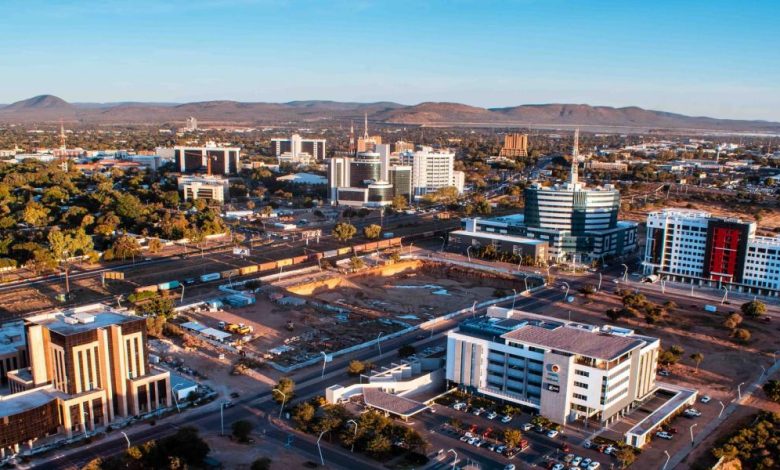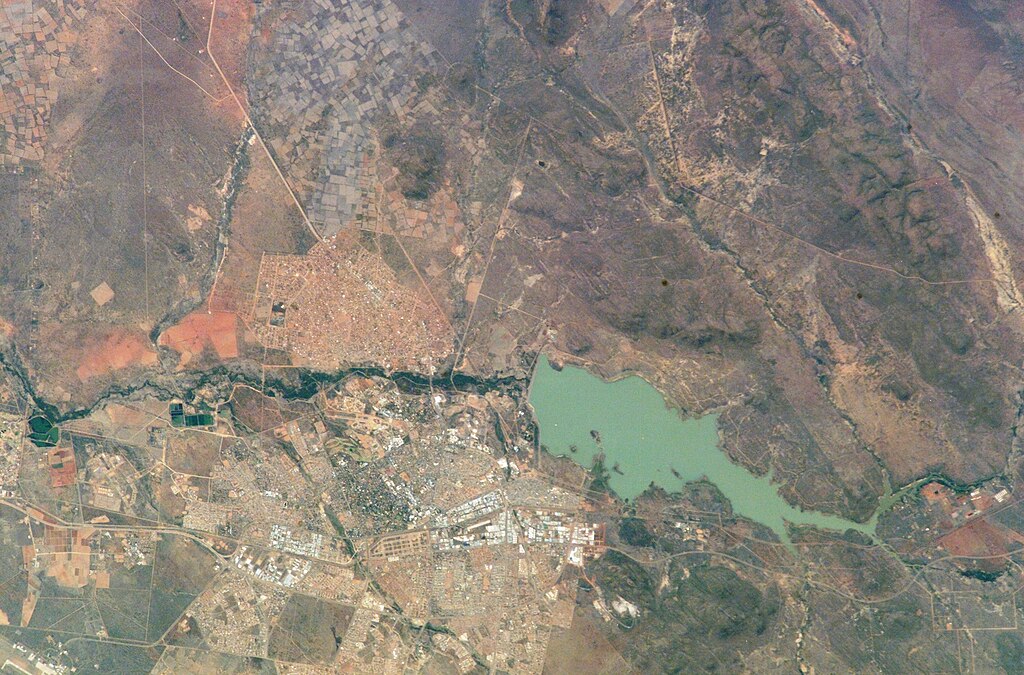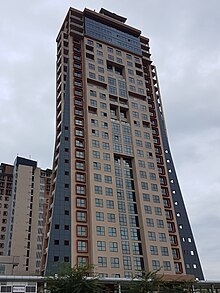Gaborone

Gaborone is the capital of Botswana and became the seat of government in 1965 when it was relocated from Mafeking, South Africa. This move preceded Botswana’s independence from Britain by a year. Situated along the Cape-Zimbabwe railway, Gaborone hosts government offices, parliament buildings, health facilities, a thermal power station, and an airport. It serves as the headquarters of the University of Botswana, established in 1976. Additionally, the town boasts a national museum and art gallery founded in 1968, featuring departments dedicated to natural history, archaeology, and prehistory.
| ID |
|---|
| 15735 |
| Name |
| Gaborone |
| State ID |
| 3064 |
| State Code |
| SE |
| State Name |
| South-East District |
| Country ID |
| 29 |
| Country Code |
| BW |
| Country Name |
| Botswana |
| Latitude |
| -24.76234000 |
| Longitude |
| 25.79950000 |
| WikiData ID |
| Q38855 |
History
For centuries, evidence suggests that the banks of the Notwane River have been inhabited by various communities. Among these, the Tlokwa people, tracing back to around 1880, made significant contributions to the region’s history. They established the settlement of Moshaweng, laying the groundwork for what would later become Gaborone.
Unveiling the Meaning Behind “Gaborone”
The name “Gaborone” carries profound significance, translating to “it does not fit badly” or “it is not unbecoming.” This moniker reflects the essence of the city, embracing a sense of belonging and resilience.
Colonial Influence and Evolution
During the colonial era, Gaberones emerged as a pivotal hub, owing much to Chief Gaborone of the Tlokwa. The city initially referred to as “Gaberones,” witnessed transformative phases under European colonizers, culminating in its renaming to Gaborone in 1969.
The Birth of a Capital: Transition to Modernity
In 1964, a momentous decision was made to designate Gaborone as the capital of Botswana, marking a significant milestone in the nation’s journey to autonomy. This move catalyzed rapid urban development and set the stage for Gaborone’s evolution into a bustling metropolis.
Urban Planning and Growth Dynamics
Gaborone’s development was meticulously planned, adhering to Garden City principles and fostering a harmonious balance between urban infrastructure and natural spaces. The city’s layout, likened to a “brandy glass,” underscores its organized architectural framework and functional design.
Socioeconomic Challenges and Resilience
Despite its rapid expansion, Gaborone grappled with socioeconomic disparities, exemplified by the proliferation of informal settlements like Naledi. Overcoming these challenges required innovative solutions and proactive governance, as demonstrated by the rezoning efforts led by President Seretse Khama.
From Independence to Present: A Vibrant Metropolis
Since gaining independence in 1966, Gaborone has undergone remarkable demographic shifts, evolving from a modest town to a bustling urban centre. Today, the city stands as a testament to Botswana’s resilience and unwavering spirit of progress.
Navigating Future Trajectories
As Gaborone continues to flourish, addressing the legacy of its developmental challenges remains imperative. Through collaborative efforts and visionary leadership, the city can chart a sustainable course for future growth, ensuring inclusivity and prosperity for all its inhabitants.
In essence, Gaborone’s journey embodies a tapestry of resilience, innovation, and cultural richness, symbolizing the enduring spirit of Botswana’s quest for progress.
Geography

Gaborone is a city located in the southeastern corner of Botswana, situated between Kgale and Oodi Hills, on the Notwane River. It lies about 15 kilometres from the South African border and has an elevation of 1,010 meters above sea level. The city is surrounded by suburbs like Ramotswa, Mogoditshane, Mochudi, and Tlokweng, which primarily serve as commuter towns. Some notable suburbs within Gaborone include Broadhurst, Gaborone West, The Village, and Naledi, with the affluent suburb of Phakalane lying about 13 kilometres north of the city centre.
The city centre features the Main Mall, housing various diplomatic missions, along with the Civic Centre and the Pula Arch, symbolizing Botswana’s independence. Nearby are significant institutions like the Botswana Stock Exchange, the National Museum and Art Gallery, and the University of Botswana’s main campus. The Government Enclave, to the west of the Main Mall, hosts governmental buildings such as the National Assembly of Botswana and the National Archives.
Gaborone experiences a hot semi-arid climate, characterized by sunny weather throughout most of the year. Summers are typically hot with cool nights, while winters see warm days and cold nights. The temperature can reach highs above 32°C for about 74 days annually and above 26°C for about 196 days annually. Conversely, there are approximately 51 days with temperatures below 7°C and rarely below freezing. The city’s dew point peaks in January and February and hits its lowest levels in July.
Rainfall in Gaborone is scarce and unpredictable, mostly occurring between October and April, with thunderstorms being common during the summer months. The city has experienced three floods since 1995, with one in 2001 causing significant damage. Humidity levels range from 28% in September to 90% in June, while solar irradiance varies from 4.1 kWh/m²/day in June to 7.3 kWh/m²/day in December. Wind speeds are higher from September to November and lower from May to August, with an average speed of 12 km/h annually.
Economy

Gaborone serves as the focal point of Botswana’s economy, housing key financial institutions like the Bank of Botswana, Bank Gaborone, BancABC, and the Botswana Stock Exchange. It also hosts headquarters for various organizations including Air Botswana, Consumer Watchdog, Botswana Telecommunications Corporation, and Debswana, a significant diamond mining venture jointly operated by De Beers and the Botswana government. Additionally, it is home to the Southern African Development Community (SADC) headquarters, established to promote economic cooperation among member states.
The city attracts investment from international companies such as Hyundai, SABMiller, Daewoo, Volvo, and Siemens. Orapa House, owned by Debswana, is a notable location where diamonds mined by Debswana are sorted and valued. Gaborone also boasts a Diamond Technology Park, reflecting the government’s vision for developing a downstream diamond industry.
Annually, the Botswana Resource Conference takes place at the Gaborone International Conference Centre. The city has an unemployment rate of 11.7% as of 2008, with 19.7% of the population employed in the financial sector. According to Mercer’s 2011 Worldwide Cost of Living Survey, Gaborone ranks 195th for expatriate cost of living, positioning it as one of the least expensive cities in Africa for expatriates.
Government
Gaborone’s governance falls under the purview of the Gaborone City Council, which comprises 35 councillors representing the city’s wards. The council operates under the Townships Act, with power delegated from the national level through the Ministry of Local Government, Land and Housing, influencing areas such as personnel, budgeting, and development planning. The council, led by the mayor and deputy mayor, oversees various committees, including those for finance, public health, housing, and education, among others. Despite efforts, the council has faced criticism for closed elections and limited authority.
As Botswana’s political hub, Gaborone hosts key government buildings in the Government Enclave, including the National Assembly, the National Archives, and various ministries. The city’s parliamentary representation has evolved over the years, with multiple constituencies established to accommodate electoral changes. Additionally, Gaborone is home to the International Law Enforcement Academy, providing training for SADC countries’ law enforcement personnel. Furthermore, it hosts 21 diplomatic missions, underscoring its international importance.
Education
Gaborone boasts a highly educated population, with more individuals holding degrees or postgraduate qualifications than anywhere else in Botswana. Approximately 70.9% of Gaborone’s population has attained at least a secondary-level education, while only 2.6% have never attended school.
The city features a variety of primary and secondary schools, both public and private, including notable institutions like Westwood International School, Maru-a-Pula School, and Legae Academy, among others. Gaborone is home to seventeen out of Botswana’s sixty private schools.
The University of Botswana’s main campus, established in 1982, is located in the eastern part of the city. Additionally, Gaborone hosts several other universities and higher education institutions, catering to specialized fields of study. These include Limkokwing University Of Creative Technology, Botswana Accountancy College, Botswana Open University, Gaborone Technical College, Boitekanelo College, Botho University, and Botswana University of Agriculture and Natural Resources.
In 2006, the Gaborone Universal College of Law opened its main campus in the city, with its first cohort of students graduating in 2010. This abundance of educational institutions underscores Gaborone’s status as a hub for higher learning in Botswana.
Demography
| Year | Pop. | ±% p.a. |
|---|---|---|
| 1964 | 3,855 | — |
| 1971 | 17,718 | +24.34% |
| 1981 | 59,657 | +12.91% |
| 1991 | 133,468 | +8.39% |
| 2001 | 186,007 | +3.37% |
| 2006 | 191,776 | +0.61% |
| 2011 | 231,626 | +3.85% |
| 2022 | 246,325 | +0.56% |
Based on the 2022 census, Gaborone has a population of 246,325, with 118,727 males and 127,598 females residing in the city. There are approximately 58,476 households in Gaborone, and in 2001, the average household size was 3.11 people. Gaborone is home to over 10% of Botswana’s population, with almost half of the country’s citizens living within 100 kilometres of the city.
The population growth rate in Gaborone is 3.4%, the highest in the country, likely due to its more developed infrastructure, making it a more desirable place to live. It is also one of the fastest-growing cities globally, with much of the growth attributed to net in-migration from other parts of Botswana.
The sex ratio in Gaborone is 96.3, indicating 963 men for every 1,000 women. A significant number of marriages in Botswana are registered in Gaborone, accounting for about 15% of all marriages in the country in 2007. On average, there are 3.3 persons per household in Gaborone, which is relatively low compared to the rest of Botswana.
Culture
The National Museum and Art Gallery, situated northwest of the Mall along Independence Road, opened in 1968. It showcases traditional crafts and artworks by local artists, including original paintings by Thomas Baines and Lucas Sithole. Exhibits cover various themes such as Artists in Botswana, Children’s Art Competition, and Thapong International. The museum also features transportation displays like wagons, sledges, and bakkies (pickup trucks), along with an exhibit on the San, southern Africa’s earliest inhabitants. Additionally, it inaugurated the National Botanical Garden in 2007, spanning 3.6 hectares and primarily housing indigenous plant species from Botswana.
The Maitisong Festival, initiated in 1987, is an annual event lasting seven days, typically held during the last week of March or the first week of April. It hosts outdoor concerts, plays, and films across various venues in the city.
During the 2000s, the “My African Dream” performing arts competition took place annually at the Gaborone International Convention Center, showcasing kwaito dancers and musicians.
The popular book series “The No. 1 Ladies’ Detective Agency” by Alexander McCall Smith is set in Gaborone, and revolves around Precious Ramotswe, Botswana’s first female private detective. Another book series, the Detective Kubu series, authored by Michael Stanley (Michael Sears and Stanley Trollip), features Assistant Superintendent David ‘Kubu’ Bengu of the Botswana Police Service Criminal Investigation Department.
Some key Places to visit
Three Chiefs Monument: Honoring Botswana’s History
Crossing the railway tracks into Gaborone’s Central Business District, visitors encounter the imposing Three Chiefs’ Monument. This statue stands as a testament to a pivotal moment in Botswana’s history. In the late 1800s, the country faced a threat from British industrialist Cecil Rhodes, who sought control over Bechuanaland for his British South Africa Company.
Three visionary chiefs—Khama III of the Bangwato, Sebele I of the Bakwena, and Bathoen I of the Bangwaketse—embarked on a journey to London in 1885. Their mission: to petition Joseph Chamberlain, the Secretary of State for the Colonies, and to seek an audience with Queen Victoria. Their efforts garnered public support in Britain, leading to the establishment of the Bechuanaland Protectorate, thus safeguarding Botswana’s sovereignty.
Crafted by skilled North Korean artisans, the monument immortalizes the three chiefs and was unveiled in 2005, marking the nation’s 39th year of independence. Today, visitors can delve into this rich history through guided tours provided by local historians.
University of Botswana: Nurturing Minds, Shaping Futures
Adjacent to the National Stadium stands the esteemed University of Botswana, affectionately known as “Mma-Dikolo” (Mother of Universities). Since its inception in 1982, this institution has played a pivotal role in the country’s development. Boasting nine faculties and a graduate school, the university has produced notable alumni, including renowned judge and human rights activist Unity Dow, statesman Duma Boko, and internationally acclaimed lawyer Beatrice Mtetwa.
Thapong Visual Arts Centre: A Haven for Creativity
Housed in a historic magistrate’s residence dating back to 1902, the Thapong Visual Arts Centre serves as a hub for Botswana’s burgeoning artistic community. Here, young talents flourish, showcasing their work through regular exhibitions. The centre also hosts children’s art courses, fostering creativity from a young age.
Indulge in Culture at The No. 1 Ladies Coffee House
Within the premises of Thapong Visual Arts Centre lies The No. 1 Ladies Coffee House, a charming eatery named after Alexander McCall Smith’s beloved novel series. Offering a blend of innovative cuisine and artistic ambience, it serves as the perfect complement to a visit to the arts centre.
Gaborone Game Reserve: Where Nature Meets the City
Nestled within Gaborone’s urban landscape lies the Gaborone Game Reserve, a unique sanctuary spanning 5 square kilometres. Home to indigenous species such as zebra, eland, and impala, as well as a variety of birdlife, this reserve offers a glimpse into Botswana’s natural wonders. Visitors can enjoy day visits and picnics amidst the diverse terrain, with educational tours available for those seeking a deeper understanding of the local ecosystem.
Support Botswana’s Cultural and Natural Treasures
As you explore Gaborone’s vibrant cultural and natural attractions, consider supporting initiatives that preserve and celebrate Botswana’s heritage. By immersing yourself in the rich tapestry of history, art, and wildlife, you contribute to the conservation of these invaluable assets for generations to come.
Further reading
- Wikipedia – https://en.wikipedia.org/wiki/Gaborone
- Botswana Tourism Organisation – https://www.botswanatourism.co.bw/explore/gaborone